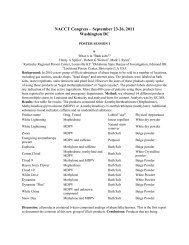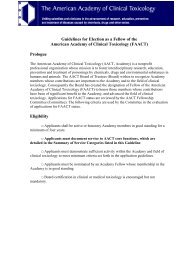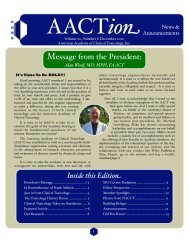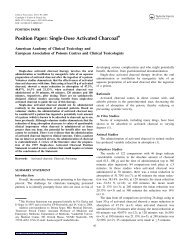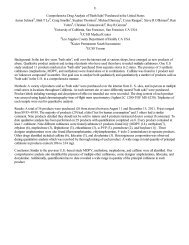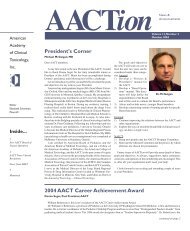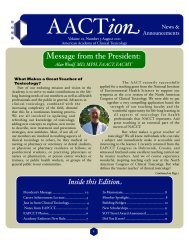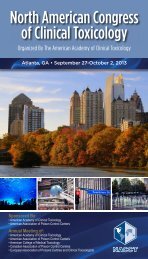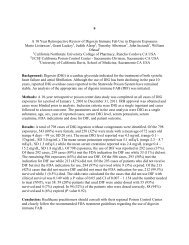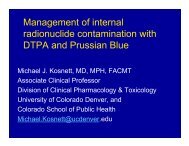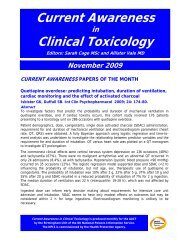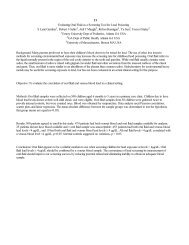Posters IV - The American Academy of Clinical Toxicology
Posters IV - The American Academy of Clinical Toxicology
Posters IV - The American Academy of Clinical Toxicology
You also want an ePaper? Increase the reach of your titles
YUMPU automatically turns print PDFs into web optimized ePapers that Google loves.
Background: During a public health emergency, such as an epidemic H1N1 situation or radiological<br />
crisis, telemedicine has great potential to address hospital surge capacity by managing care for patients<br />
who have mild or no symptoms. Poison Control Centers (PCC) can serve a large number <strong>of</strong> patients using<br />
set treatment guidelines under the supervision <strong>of</strong> medical pr<strong>of</strong>essionals. In order to optimize call center<br />
disaster telemedicine services, it is important to understand public opinions. Methods: Participants were<br />
selected each month from recent callers to the Georgia Poison Center (GPC). Eligibility included members<br />
<strong>of</strong> the general public who were at least 18 years old, had placed a call to the GPC between two weeks and<br />
two months prior to study enrollment date, and received management relating to their exposure at home.<br />
<strong>The</strong> research employed was a cross-sectional survey design. <strong>The</strong> survey consisted <strong>of</strong> 21 items which<br />
assessed the demographic characteristics <strong>of</strong> participants, knowledge and attitudes towards telemedicine,<br />
and aspects related to a hypothetical epidemic <strong>of</strong> H1N1 flu. Results: Based on the eligibility, 491 PCC<br />
callers were eligible for enrollment. Individuals were then called at random and invited to participate. In<br />
total, 116 individuals completed the telephone survey and were enrolled in the study. Of these<br />
participants, 84.5% were female and the mean age was 38 years old; 69.8% indicated they were white,<br />
22.4% black, and 2.6% Hispanic. Level <strong>of</strong> education varied, but 73.3% <strong>of</strong> respondents indicated having<br />
completed some college or more. Many callers (45.7%) reported living in a suburban area. Based on the<br />
telephone survey, 66.4% <strong>of</strong> respondents indicated they were aware <strong>of</strong> telemedicine and 72.4% indicated<br />
they were likely or very likely to use telemedicine services. In addition to demonstrating knowledge and<br />
likelihood, 67.2% <strong>of</strong> participants said they were very or extremely willing to follow medical care<br />
instructions through telemedicine for treating themselves and 61.2% for treating other family members.<br />
Discussion: During a public health crisis, telemedicine may provide medical advice for patients with<br />
minor or no symptoms and has potential to alleviate capacity constraints at acute care hospitals and<br />
medical care facilities. <strong>The</strong> majority <strong>of</strong> participants had knowledge <strong>of</strong> telemedicine, were likely to use it,<br />
and were willing to follow telemedicine instructions for themselves or other family members during a<br />
public health emergency. Conclusion: This study supports the use <strong>of</strong> poison centers as potential<br />
telemedicine providers during a public health emergency. Telemedicine could serve as an additional<br />
resource for treatment during times <strong>of</strong> overwhelming demands on the acute care system.<br />
267<br />
What do other countries want from the ACMT? Results <strong>of</strong> the <strong>American</strong> College <strong>of</strong> Medical <strong>Toxicology</strong><br />
International Committee Survey.<br />
David M Wood 1 , Paul Wax 2 , Lewis Nelson 3 , Rais Vohra 4 , Paul I Dargan 1<br />
1 Guy's and St Thomas' NHS Foundation Trust, London UK 2 <strong>American</strong> College <strong>of</strong> Medical <strong>Toxicology</strong>,<br />
Phoenix AZ 3 New York University, New York NY 4 UCSF-Fresno Medical Center, Fresno CA USA<br />
Background: <strong>The</strong> International Committee <strong>of</strong> the <strong>American</strong> College <strong>of</strong> Medical <strong>Toxicology</strong> (ACMT) was<br />
established as a forum for members from outside <strong>of</strong> the USA and to provide support to its International<br />
members. Since it was not clear what the exact needs <strong>of</strong> medical toxicologists around the world were, an<br />
Internet-based survey was designed to determine these needs and we describe here the interim results <strong>of</strong><br />
this survey. Methods: A multi-page self-completion on-line questionnaire was designed and trialled by<br />
the ACMT International Committee. Delivery was through an on-line survey portal, with individuals<br />
invited to complete the questionnaire by personalised electronic mail invites to key individuals within 81<br />
different countries. <strong>The</strong> key individuals were identified using personal contacts through the ACMT, and<br />
where possible only one representative individual per country was invited to complete the questionnaire.<br />
<strong>The</strong> questionnaire included sections on medical toxicologist recognition / accreditation and training,<br />
poisons centres, antidote availability, laboratory support, training and teaching, and a needs assessment



